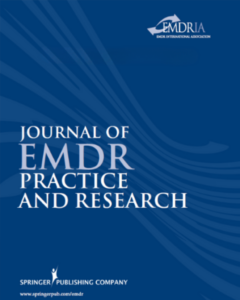Eye Movement Desensitization and Reprocessing and Slow Wave Sleep: A Putative Mechanism of Action (Frontiers in Psychology)
The slow wave sleep hypothesis tries to explain how EMDR works and is discussed in light of other theories and neurobiological findings.
Read MoreAuditory and visual memories in PTSD patients targeted with eye movement and counting: The effect of modality-specific loading of working memory (Frontiers in Psychology)
This study tested whether auditory memories can be targeted with EMDR in PTSD patients and whether taxing the patient (performing a dual task while recalling a memory) in a modality specific way (auditory demanding for auditory memories and visually demanding for visual memories) was more effective in reducing the emotionality experienced than taxing in cross-modality.
Read MoreGrey matter density changes of structures involved in posttraumatic stress disorder (PTSD) after recovery following eye movement desensitization and reprocessing (EMDR) therapy (Psychiatry Research)
Study aimed to determine whether symptoms improvement is associated with grey matter density changes of brain structures involved in PTSD.
Read MorePre-treatment cortisol awakening response predicts symptom reduction in posttraumatic stress disorder after treatment (Psychoneuroendocrinology)
Are treatment successes in PTSD associated with changes in cortisol secretion, assessed by HPA-axis function, before & after trauma therapy?
Read MoreExploring expectation effects in EMDR: Does prior treatment knowledge affect the degrading effects of eye movements on memories? (European Journal of Psychotraumatology)
Study designed to test whether expectations about the working mechanism of EMDR would alter the memory attenuating effects of eye movements.
Read MoreBilateral alternating auditory stimulations facilitate fear extinction and retrieval (Frontiers in Psychology)
An animal model of fear recovery showed that BLS facilitate fear extinction and fear extinction retrieval, can this work in humans too?
Read MoreEye movement during retrieval of emotional autobiographical memories (Acta Psychologica)
This study assessed whether specific eye movement patterns are observed during emotional autobiographical retrieval.
Read MoreMorphovolumetric changes after EMDR treatment in drug-naïve PTSD patients (Rivista Di Psichiatria)
We administered the Clinician Administered PTSD Scale (CAPS) and conducted brain MRI measurements (with Optimized Voxel-Based Morphometry).
Read MoreRestoration of emotional control ability in PTSD following symptom amelioration by EMDR therapy (European Journal of Trauma & Dissociation)
How the ability to control for emotional responses is altered in PTSD and it can be restored after EMDR treatment suppressing core symptoms.
Read MoreEMDR and the sleep connection: EMDR may work because of its similarity to dream sleep (Psychology Today)
It is also possible that EMDR works by engaging similar brain mechanisms as those that underpin rapid eye movement (REM) sleep.
Read MoreDegrading traumatic memories with eye movements: A pilot functional MRI study in PTSD (European Journal of Psychotraumatology)
Script driven imagery before & after recall of traumatic memories is feasible to investigate working mechanisms with eye movements in PTSD.
Read MoreCohérence électroencéphalographique, vivacité des souvenirs et effets de valence émotionnelle des mouvements oculaires bilatéraux pendant le rappel de souvenirs désagréables et l’association libre subséquente : implications pour l’EMDR (Journal of EMDR Practice and Research)
Cette étude a examiné les effets de la stimulation bilatérale pendant le rappel de souvenirs désagréables suivi d’association libre, de…
Read More


